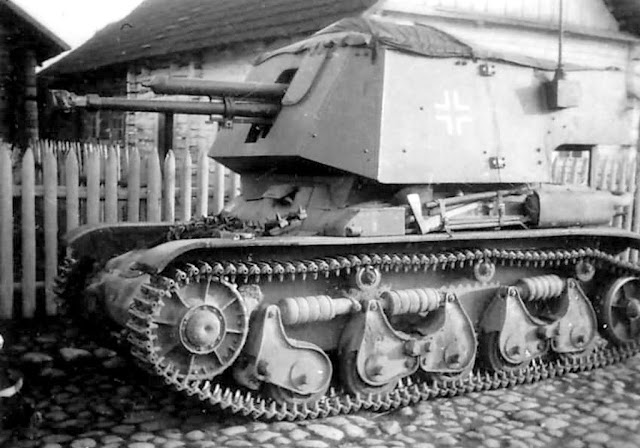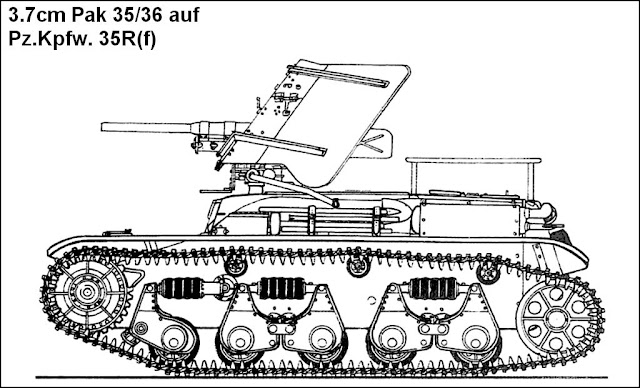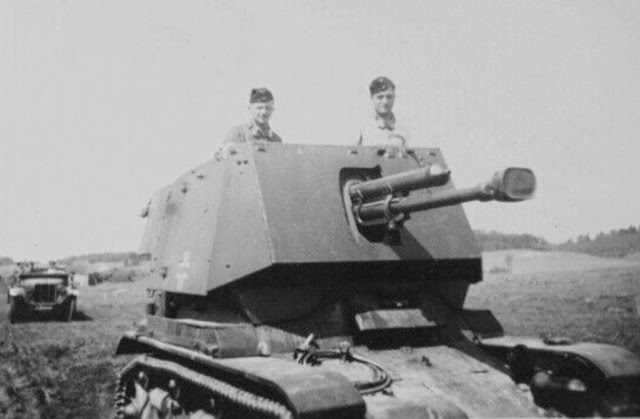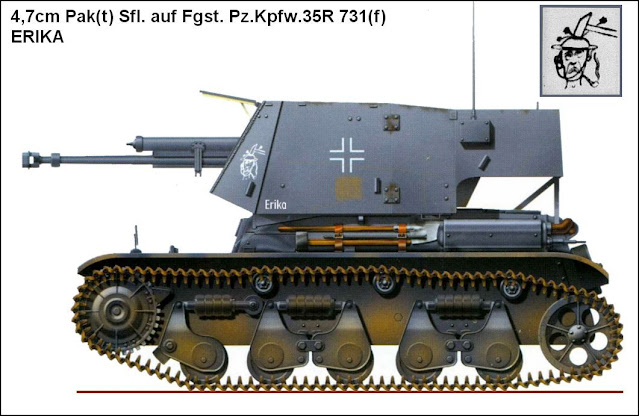Jäger Kameraden!!!
Let's look at one more small weapon that was designed to fill a gap in a self-propelled anti-tank weapon that could be used by German forces while more powerful and deadly weapons were not yet available in sufficient numbers. The use and transformation of captured material in good condition into truly deadly vehicles was almost a characteristic of the German Army.
Today, we're going to visit this little girl who carries an efficient and deadly weapon: We're talking about 4,7cm Pak(t) Sfl. auf Fgst. Pz.Kpfw.35 R 731(f). I built this girl in 2002.
 |
Drawing modified from Hobby Boss 4.7cm Pak(t) Sfl.auf Fgst. Pz.Kpfw.35R 731(f) (#83807) box art kit. |
 |
| A 4,7cm Pak(t) Sfl. auf Fgst. Pz.Kpfw.35 R 731(f) - Panzerjäger I ready for action! |
History:
Panzerjäger (German "armour-hunters" or "tank-hunters", abbreviated to Pz.Jg. in German) was a branch of service of the German Wehrmacht during the Second World War. It was an anti-tank arm-of-service that operated self-propelled anti-tank artillery, and made exclusive use of the tank destroyers, which were also named Panzerjäger. Soldiers assigned to tank hunting units wore ordinary field-gray uniforms rather than the black of the Panzer troops, while Panzerjäger vehicle crews wore the Panzer jacket in field gray.
Development:
From 1940, the Panzerjäger troops were equipped with vehicles produced by mounting an existing anti-tank gun complete with the gun shield on a tracked chassis (german or captured) to allow higher mobility. The development of Panzerjägers into the fully protected Jagdpanzer armored vehicle designs began before the war with the Sturmgeschütz - designated armored artillery vehicles, the initial German turretless tanks to use completely closed-in armored casemates, and continued until 1944, resulting in the fully enclosed Jagdpanzer "hunting tanks", purpose-built heavy-gun tank destroyers. These usually used upward extensions of both the glacis plate and hull sides to comprise three sides of their closed-in casemates. Panzerjäger continued to serve as a separate branch of the Heer until the end of the war, often replacing tanks due to production shortages.
Initially, the use of German light tanks with an upgrade to their main weapons was initially the most obvious option, with the featherweight Panzer I tanks (Ausf A and B) the first test vehicles of this concept.
 |
| Light tank Panzerkampfwagen I Ausf A Takom (#1008) box art |
These small, agile and reliable tanks had their turrets (2 × 7.92 mm MG 13 machine guns) removed and in their place 3,7cm Pak 36 (Panzerabwehrkanone 36) guns were fitted, providing a cost-effective solution to the German shortage of mobile anti-tank weapons in infantry divisions.
Despite the shortcomings of light armour and high silhouette, they were successfully used in their intended role of a self-propelled anti-tank gun. The same recipe was also used in captured vehicles. After the Battle of France and the first steps of Operation Barbarossa, Germany used several British, French and Soviet vehicles, collected in good condition, for this purpose. The anti-tank weapon used for these adaptations was the small 3,7cm Pak 35/36 gun, which was beginning to show its penetration weakness in the face of the evolution of the new tanks at the time. See some examples below...
 |
| 3.7cm Pak 35/36 AT gun installed on a British Bren-carrier. |
 |
| 3.7cm Pak 35/36 AT gun installed on a French Renault UE light tractor |
 |
| 3.7cm Pak 35/36 AT gun installed on a French R-35 light tank |
 |
| 3.7cm Pak 35/36 AT gun installed on a Soviet light tractor Komsomoletz |
Neither anti-tank guns nor Panzerjägers had any real armor to speak of, and while the Panzerjäger had a higher silhouette and was more visible than an anti-tank gun, it was also much more mobile, and was able to relocate or retreat far more rapidly than conventional anti-tank gun crews. The lack of armor meant little until the self-propelled guns began to take on more and more of the offensive duties of tanks as the war progressed and production lagged.
The 4,7cm Pak(t) Sfl. auf Fgst. Pz.Kpfw.35 R 731(f)
On the end of December 1940, Waffenamt 6 started a design project for installing the very good 4.7 cm Pak(t) onto the captured chassis (Fahrgestell Fgst.) of French light tank Renault R-35 (Pz.Kpfw. 35R-731(f)) to create a PaK auf Selbstfahrlafette (Sfl.) (self-propelled anti-tank gun). Originally, these were intended to be assigned to Infanterie-Divisionen that were not motorized.
 |
| A 4,7cm PaK 36 (t) AT gun being towed by a Wehrmacht light truck in the early stages of WWII. |
 |
4,7cm KPÚV vz. 38 AT gun Military Museum Lešany Central Bohemian Region of the Czech Republic |
 |
| French R35 Light Infantry Tank HobbyBoss (#83806) box art |
 |
| Captured Renault R-35light tank |
 |
| Panzerkampfwagen 35R (f) 12th Special Operations Tank Company Notice typical Germanic transformation of the two-piece turret hatch instead of a Commander cupola. Yugoslavia, 1942. |
A test vehicle development and construction contract was awarded to Alkett in Berlin-Borsigwalde. This first example of a 4.7cm Pak(t) Sfl. auf Fgst.Pz.Kpfw.R35(f) with a carbon-steel (not armor) casemate was completed on 8 February 1941. Demonstrated to Hitler on 31 March 1941, it was announced that a series of 200 had been ordered. The contract for assembly of 200 4,7cm Pak(t) Sfl auf Fgst Pz.Kpfw.35 R 731 was awarded to Alkett, which began work in February 1941 to meet a schedule for delivery of 30 per month starting in March 1941
 |
Two Panzerjager I - 4,7cm Pak(t) Sfl. auf Fgst. Pz.Kpfw.35 R 731(f) newly renovated and photographed outside Alkett. Germany, May 1941. |
Delays occurred, with the first 93 reported as completed in May 1941, followed by 33 in June, 5 in July, 22 in August, 28 in September, and the last 19 in October 1941.
 |
| Several new 4,7cm Pak(t) Sfl. auf Fgst. Pz.Kpfw.35 R 731(f) waiting to be delivered to combat units - Germany - 1941 |
Out of the total of 200, 174 were completed as Panzerjäger with 47mm gun and 26 as Command vehicles (Fuehrungs-Fahrzeuge), with a 7.92mm MG.34 in a ball-mount instead of a 4.7 cm Pak (t).
 |
| Versions of Fgst. Pz.Kpfw. 35 R 731(f): Destroyer and Command vehicles |
Three units issued with the type: Pz.Jg.Abt 559, 561 and 611 were to be formed and established at army troop level. As ordered on 27 February 1941 by the OKII Organizations-Abteilung, Panzer-Jaeger-Abteilung 559, 561 and 611 were to be rearmed with 4.7cm Pak(t) (Sfl.) beginning in April. Each of these battalions consisted of an HQ unit and three Kompanie (Companies). Each Kompanie was to consist of three platoons (Züge) with three Sfl. in each platoon (Zug). There was an additional Kompanie sent to the Panzer-Jaeger-Abteilung 43, supplied with a few vehicles, to act as a reserve and training unit. The remaining vehicles would be mainly distributed in smaller numbers to various Infantry Divisions.
 |
Three brand new 4,7cm Pak(t) Sfl. auf Fgst. Pz.Kpfw.35 R 731(f)s on a training mission. France - Spring, 1941. |
 |
| 4,7cm Pak(t) Sfl. auf Fgst. Pz.Kpfw.35 R 731(f) being transported by rail car in the Spring of 1941. |
Panzerjäger-Abteilung (Sfl.) 559, 561 and 611 were outfitted with the first 81 4.7cm Pak(t) Sfl. auf Pz.Kpfw.35R 731(f) and 12 Fuehrungs-Fahrzeuge that had been completed in May/June 1941.
At the start of Operation "Barbarossa" on 22 June 1941, Pz.Jg.Abt.(Sfl.35R) 559 was assigned to the Heeresgruppe Nord, Pz.Jg.Abt.(Sfl.35R) 561 and Pz.Jg.Abt.(Sfl.35R) 611 in Heeresgruppe Mitte.
 |
| Two 4.7cm Pak(t) Sfl. auf Pz.Kpfw.35R 731(f)s puffing on a dusty Russian road, on their way to the East. Operation Barbarossa - August, 1941 |
Things didn't go well for these little destroyers in the early days of operation on the Soviet Front: on 5 July 1941, the Commander of the Pz.Jg.Abt.611 reported that all French vehicles were inoperative due to mechanical failure.
 |
4,7cm Pak(t) Sfl. auf Fgst. Pz.Kpfw.35 R 731 apparently abandoned by mechanical breakdown. Somewhere in the Russian front. Autumn - 1941. |
 |
| Two 4.7cm Pak(t) Sfl. auf Pz.Kpfw.35R 731(f)s in light maintenance and ammo loading, in preparation for combat. Operation Barbarossa - August, 1941 |
 |
| Platoons of 4.7cm Pak(t) Sfl. auf Pz.Kpfw.35R 731(f) followed by Sd.Kfz.10s. Normally, a 1 ton Sd.Kfz.10 armed with M.G.34 mounted for anti-aircraft defense was assigned to each platoon for transporting extra ammunition and towing an ammunition trailer. |
 |
| Another photo with the duo 4.7cm Pak(t) Sfl. auf Pz.Kpfw.35R 731(f) and the 1 ton. Sd.Kfz.10 |
 |
| 4.7cm Pak(t) Sfl. auf Pz.Kpfw.35R 731(f) maneuvering in a ditch near Stariza - Russia |
 |
| Three 4.7cm Pak(t) Sfl. auf Pz.Kpfw.35R 731(f) and Sd.Kfz.10 encamped near Stariza - Russia |
 |
| Group of 4.7cm Pak(t) Sfl. auf Pz.Kpfw.35R 731(f) in the woods Russia front, near Stariza. |
 |
| The Commander tries to hear something on his radio, while this 4.7cm Pak(t) Sfl. auf Pz.Kpfw.35R 731(f) passes an overturned Soviet T-34 on a Russian country road in the dirty Autumn of 1941. |
The situation got even worse with the arrival of low temperatures, with the chassis and engines of the 4.7cm Pak(t) Sfl. auf Pz.Kpfw.35R 731(f) not withstanding the rigors of the Russian winter well. In an experience report from February 1942, the unit reported a catastrophe had occurred due to weak engines, poor roads, and weather conditions. At minus 10 degrees Celsius, the French engines simply refused to start and the lubricant froze on the axles, locking up the entire undercarriage. The design of parallel ribs on the track links caused vehicles to slide and skid on icy roads.
Despite initial failures on the Russian Front, the 4.7cm Pak(t) Sfl. auf Pz.Kpfw.R35(f) was kept in active service on the East and West front lines, mainly in the West, after a massive mechanical repair.
 |
| A 4.7cm Pak(t) Sfl. auf Pz.Kpfw.35R 731(f) with his crew waiting to be transported by a 10 ton 2-axle trailer Sd. Ah. 115. Take a look at the mats made from wooden logs, attached to the superstructure's armor and the front hull. |
 |
| A Fuehrungs-Fahrzeuge mit Fgst. Pz.Kpfw.35R 731(f) somewhere on the Eastern front - 1942. Notice the jerry-cans in the rear deck. |
 |
| 4,7cm Pak(t) Sfl. auf Fgst. Pz.Kpfw.35R 731(f), motorcycles and horse carts moving through a forest in northern Russia. Summer - 1941 |
 |
| 4,7cm Pak(t) Sfl. auf Fgst. Pz.Kpfw.35R 731(f) waiting with his crew, somewhere in West Front France - 1942. |
Strength reports from late June to December 1943 record that in the West there were 6 with Pz.Jg.Abt.657, 3 with Pz.Rgt.100, 8 to 10 with 18.Lw.Feld.Div., 8 with 156.Res.Div., 10 with 171.Res. Div., 10 with 191.Res.Div., 2 with 243.Inf.Div., 2 with 266.Inf.Div., 11 with 343.Inf.Div., 2 with 346.Inf.Div., 6 with 348.Inf.Div., 2 with 371.Inf.Div., 5 with 709.Inf.Div., 2 with 711.Inf.Div., 2 with 712.Inf.Div., 2 with 716.Inf.Div., 10 with Festungsstamm-Abt.1/XXV, and 24 on the channel islands of Guernsey and Jersey with the 319.Inf.Div. (font: Panzer-Tracts 7-1)
 |
| 4.7cm Pak(t) Sfl. auf Pz.Kpfw.35R 731(f) passing a 1.5 ton Opel Blitz somewhere on the West Front - Autumn 1943. |
A very high percentage of the 4.7cm Pak(t) Sfl. auf Pz.Kpfw.R35(f) were operational with these garrison units - 85 out of 96 in late June 1943, and 88 out of 92 in December 1943. Indeed, the milder conditions on the Western Front were more conducive to the mechanical survival of the small destroyer Renault. Between 1942 and 1944, surviving vehicles were mainly used for occupation and patrol duties and crew training.
 |
| 4,7cm Pak(t) Sfl. auf Fgst. Pz.Kpfw.35R 731(f)s in transit. |
 |
The 4.7cm Pak(t) Sfl. auf Pz.Kpfw.35R 731(f) ERIKA in patrol in the dunes of Normandy Beaches, 1942. These references are on most websites and books, but nothing about the unit... |
In the color profile below, notice the cartoon on the vehicle's front armor: a hammer hitting a British infantryman's head locates our destroyer in the Western Theater of Operations... Maybe some rancor or challenge right after the Battle of France... Really, everything suggests that this vehicle is in Western Front, in the quiet days of 1941-42!!
 | ||
| 4.7cm Pak(t) Sfl. auf Pz.Kpfw.35R 731(f) ERIKA color profile. |
 |
| Another 4.7cm Pak(t) Sfl. auf Pz.Kpfw.35R 731(f) in patrol The Unit and landscape appear to be the same as in the photo (and profile) above. |
On July 30, 1941, Wa Pruef 6 awarded Alkett a contract to design and produce a prototype of the chassis Sfl. auf Pz.Kpfw.R35(f) armed with more powerful anti-tank weapon, the 5.0 cm Pak 38.
 |
| Profile drawing of what would be 5,0cm Pak38 Sfl. auf Fgst.Pz.Kpfw.35R 731(f), the destroyer equipped with the powerful 5.0cm Pak38 anti-tank gun. |
With an armor superstructure 25 mm thick on the front and 20 mm on the sides and manned by a crew of three, the 5,0cm Pak38 Sfl. auf Fgst.Pz.Kpfw.35R 731(f) was predicted to weigh 11.5 metric tons and have a maximum speed of 20 km/h. This vehicle was scheduled to be delivered and tested in August 1941, but reports on this fact were lost.
The still operational 4.7cm Pak(t) Sfl. auf Pz.Kpfw.35R 731(f)s fought their last battles fighting against the Allied Invasion of Normandy, where the limitations of age and lightness of armament were evident. But I don't agree with what I read in many references. that such vehicles in 1944 were "useless rubbish". IMHO, "...a small gun is better than none!"
And I think that whoever writes such nonsense has never seen the result of a 47mm projectile fired on bodies, trucks or even armor in more unprotected areas of some tanks... If I were in combat, inside a fox hole , behind a hedge or over a truck, the last thing I would want to see would be one of those "poor French junk" pointing its "weak" 47mm gun at me!!!
 |
| Knocked-out 4,7cm Pak(t) Sfl. auf Fgst. Pz.Kpfw.35R 731(f) inspected by American soldiers Le Molay-Littry - France. 20 Jun 1944 |
 |
4,7cm Pak(t) Sfl. auf Fgst. Pz.Kpfw.35R 731(f) and Pz.Kpfw.35R 731(f) light tank destroyed by Allied Forces in the Battle of Paris France - August, 1944. |
 |
| A captured 4.7cm Pak(t) Sfl. auf Pz.Kpfw.35R 731(f) being part of the fortifications of the Atlantikwall - 1945 |
Later, the Allies would meet them again at Arnhem, where they equipped Pz.Jg.Abt.684 (commanded by Hauptmann Pulkowski) and possibly the 59. Infanterie-Division.
 |
4,7cm Pak(t) Sfl. auf Fgst. Pz.Kpfw.35 R 731(f) 's-Hertogenbosch - Netherlands. September -1944 |
 |
| Captured 4,7cm Pak(t) Sfl. auf Fgst. Pz.Kpfw.35 R 731(f) right side view |
 |
| Captured 4,7cm Pak(t) Sfl. auf Fgst. Pz.Kpfw.35 R 731(f) left side view |
Of all 200 reconstructed vehicles, only one 4,7cm Pak(t) Sfl. auf Fgst. Pz.Kpfw.35 R 731(f) is preserved. This brave little girl can be seen exposed to the weather with many parts of the rear superstructure missing, at the Military Museum in Thun, in Switzerland.
 |
| 4.7cm Pak(t) Sfl. auf Pz.Kpfw.R35(f) - right view Notice the rear superstructure missing. Military Museum - Thun, Switzerland |
 |
| 4.7cm Pak(t) Sfl. auf Pz.Kpfw.R35(f) - left view Notice the rear superstructure missing Military Museum - Thun, Switzerland |
 |
| 4.7cm Pak(t) Sfl. auf Pz.Kpfw.R35(f) - 3/4 rear view Notice the rear parts missing... Military Museum - Thun, Switzerland |
 |
| Captured 4.7cm Pak(t) Sfl. auf Pz.Kpfw.R35(f) - 3/4 rear left view Compare with the picture above... |
Specs:
| 4,7cm PaK(t) auf Pz.Kpfw.35R 731(f) | |
|---|---|
| Type | Tank destroyer |
| Place of origin | France - Nazi Germany |
| Service history | |
| In service | 1941–44 |
| Used by | Nazi Germany |
| Wars | World War II |
| Production history | |
| Designer | Renault - Alkett |
| Designed | 1941 |
| Produced | 1941 |
| No. built | 200 (including 26 comm.) |
| Specifications | |
| Mass | 10 ton |
| Length | 4.30 m |
| Width | 1.87 m |
| Height | 2.30 m |
| Crew | 3 |
| Elevation | -8° to +10° |
| Traverse | 17.5 º L - 17.5 º R |
| Armor | 40mm chassis - 25mm shield |
Main armament | 4.7cm Pak(t) - 84 rds. ammo |
| Engine | Renault V-4 gasoline engine 82 hp @ 2200 rpm |
| Power/weight | 8 hp / tonne |
| Transmission | 4 speed x 1 rev. |
| Suspension | rubber cylinders springs |
| Ground clearance | 32 cm |
| Fuel capacity | 168 liters |
Operational range | 130 km road 80 Km off road |
| Maximum speed | 20 km/h |
The kit:
This project is very old...from the beginning of the XXI Century (2002), when the excellent Hobby Boss 4.7cm Pak(t) Sfl.auf Fgst. Pz.Kpfw.35R 731(f) (#83807) kit did not exist yet...
 |
| Hobby Boss 4.7cm Pak(t) Sfl.auf Fgst. Pz.Kpfw.35R 731(f) (#83807) box art kit |
To build this cute thing, I had to use the Heller's old kit Renault R35 & Canon de 25 (#81133) and...
 |
| Heller´s Renault R35 & Canon de 25 (#81133) box art |
 |
| Conversion kit Panzerjager 35R (#2-012) - Commander Series Models box art |
 |
| 4,7 cm. Skoda KPÚV vz 38 (#TG-49) gun metal kit instructions sheet |
 |
| 4,7 cm. Skoda KPÚV vz 38 (#TG-49) gun metal kit package |
 |
| 4,7 cm. Skoda KPÚV vz 38 (#TG-49) gun metal kit parts: metal and resin muzzle brake. |
In those distant times, access to a digital camera was a privilege for few...and the few images I have of this constructive stage are as follows, but they give a good idea of what the conversion kit was like: photo-engraved metal parts and resin parts, very well made...
 |
| Notice the casemate made in metal, with ammo bin in resin, in the rear... |
 |
| The original Commander 47mm gun, cast in white metal, was obscene (red arrow). The replacement by Jordi Rubio was essential (blue arrow) |
 |
| 3/4 right front view of the kit under constriction |
 |
| Even though the kit was good, those bubbles in the polyurethane resin were unpleasant... but it was something easy to correct... |
Instead of filling the hundreds of little bubbles with putty, I opted for laminating the top of the ammo depot with an extremely thin plasticard plate. It was great and did not interfere with the dimensions of the model...
 |
| The new roof of ammo bin... Perfect!! Notice the radio antenna, made with an acupuncture needle! |
 |
| The original Heller´s vinyl tracks... Not the best, but fully acceptable... Notice the details in the gun´s breech, made with copper wire... |
 |
| Right side |
 |
| The Notek lamp came from my junk box... |
 |
| Really, this vehicle (and kit...) is very cute!!! |
 |
| The little Franco-German girl ready to be put on... |
But so that things don't get too delicate, I decided to make a scheme of markings the time of the Allied Invasion, when these brave and fragile girls faced forces in number and quality much greater... But they didn't surrender without a good fight.
Meet Altes Schwein (Old Pig), a 4,7cm Pak(t) Sfl. auf Fgst. Pz.Kpfw.35R 731(f) belonging to Army Group B, 89th Army Corps, 15th German Army, 712th Infantry Division (Wehrmacht), 712nd Anti-tank Company - Platoon A, in batltes around Sheldt River (near Antwerp), in Belgium. September 1944.
 |
| 4,7cm Pak(t) Sfl. auf Fgst. Pz.Kpfw.35R 731(f) 3/4 front right side |
 |
| 4,7cm Pak(t) Sfl. auf Fgst. Pz.Kpfw.35R 731(f) left side. Notice 3 kills marks... maybe allied Stuarts light tanks... |
 |
| 4,7cm Pak(t) Sfl. auf Fgst. Pz.Kpfw.35R 731(f) 3/4 rear left side |
 |
| 4,7cm Pak(t) Sfl. auf Fgst. Pz.Kpfw.35R 731(f) 3/4 rear right side |
 |
| 4,7cm Pak(t) Sfl. auf Fgst. Pz.Kpfw.35R 731(f) right side |
 |
| 4,7cm Pak(t) Sfl. auf Fgst. Pz.Kpfw.35R 731(f) top left view |
 |
| 4,7cm Pak(t) Sfl. auf Fgst. Pz.Kpfw.35R 731(f) top right view |
 |
| 4,7cm Pak(t) Sfl. auf Fgst. Pz.Kpfw.35R 731(f) top view |
 |
| 4,7cm Pak(t) Sfl. auf Fgst. Pz.Kpfw.35R 731(f) front 3/4 top view |
 |
| 4,7cm Pak(t) Sfl. auf Fgst. Pz.Kpfw.35R 731(f) with Kojak and Rover, the dog. |
 |
| Kojak loved the looks of the little destroyer... |
 |
Two German destroyers with a French soul: 4,7cm Pak(t) Sfl. auf Fgst. Pz.Kpfw.35R 731(f) |














Hi Marco, un gran trabajo y la maqueta es de gran calidad. Me gusta toda la investigacion historica previa que realizas y lo espectacular de tus trabajos. La informacion sobre este vehiculo es excepcional.
ResponderExcluirUn saludo desde Argentina.
Jose
Hello Marco, a great job and the model is of great quality. I like all the previous historical research you do and how spectacular your work is. The information on this vehicle is exceptional.
Greetings from Argentina.
Joseph
Holla, Joseph!!!
ExcluirBienvenido y vuelve cuando quieras!!! Muchas gracias por sus amables palabras de elogio... ¡Muchas gracias de verdad!
¡¡¡Cuídate y saludos!!!